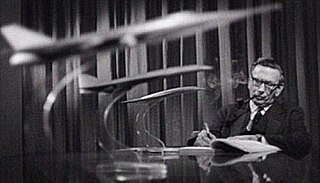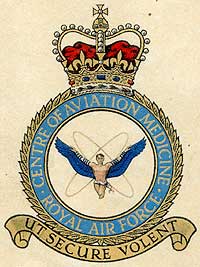Related Research Articles

The Royal Aircraft Establishment (RAE) was a British research establishment, known by several different names during its history, that eventually came under the aegis of the UK Ministry of Defence (MoD), before finally losing its identity in mergers with other institutions.

The Air Accidents Investigation Branch (AAIB) investigates civil aircraft accidents and serious incidents within the United Kingdom, its overseas territories and crown dependencies. It is also the Space Accident Investigation Authority (SAIA) for the United Kingdom. The AAIB is a branch of the Department for Transport and is based in the grounds of Farnborough Airport, Hampshire.

Royal Air Force Henlow or more simply RAF Henlow is a Royal Air Force station in Bedfordshire, England, equidistant from Bedford, Luton and Stevenage. It houses the RAF Centre of Aerospace Medicine and the Joint Arms Control Implementation Group (JACIG), and was home to the Signals Museum, which closed in June 2024. It formerly hosted light aircraft flying and 616 Volunteer Gliding Squadron. The Ministry of Defence announced on 6 September 2016 that the base is set to be closed. As of January 2024, the closure and disposal of the station is expected to take place from 2026. Flying activity ceased in July 2020.

Harold Roxbee Cox, Baron Kings Norton was a British aeronautical engineer. He was notable for his contributions to British industry, particularly aeronautical engineering, and for his part in the establishment of Cranfield University.

Air Chief Marshal Sir Roderic Maxwell Hill, was a senior Royal Air Force commander during the Second World War. He was a former Rector of Imperial College and Vice-Chancellor of London University. The Department of Aeronautics of Imperial College was situated in a building named after him.

Sir Morien Bedford Morgan CB FRS, was a noted Welsh aeronautical engineer, sometimes known as "the Father of Concorde". He spent most of his career at the Royal Aircraft Establishment (RAE), before moving to Whitehall for ten years as the Controller of Aircraft within the Ministry of Aviation. He spent the last years of his life as master of Downing College, Cambridge.

William Francis Forbes-Sempill, 19th Lord Sempill,, was a Scottish peer and record-breaking air pioneer, who was later shown to have passed secret information to the Imperial Japanese military before the Second World War. Educated at Eton, he began his career as a pilot in the Royal Flying Corps, and then served in the Royal Naval Air Service and Royal Air Force during the First World War. In 1921, Sempill led an official military mission to Japan that showcased the latest British aircraft. In subsequent years, he continued to aid the Imperial Japanese Navy in developing its Navy Air Service.
Air Marshal Sir Timothy Michael Anderson, is a retired senior Royal Air Force (RAF) officer. He served as the inaugural Director-General of the UK Military Aviation Authority (MAA) from 2010 to 2013. The MAA was established in response to the Haddon-Cave Review into the issues surrounding the loss of an RAF Nimrod over Afghanistan in September 2006. Earlier in his career, Anderson was a fast jet pilot, primarily flying the Tornado ground attack aircraft, and as Officer Commanding No. 14 Squadron led the United Kingdom's Tornado commitment to Operation Allied Force, the NATO air campaign over Kosovo in 1999, for which he was awarded the Distinguished Service Order. He is currently Chairman of the UK Airspace Change Organising Group Steering Committee, overseeing a national infrastructure programme on behalf of the Secretary of State for Transport and the UK Civil Aviation Authority.
Controller Aircraft (CA), originally Controller of Aircraft, is a senior British Ministry of Defence appointment who is responsible for delivering an airworthy aircraft to the Services, whereupon the Service issues a Release to Service (RTS), releasing the aircraft into service. The difference between CA Release and RTS is normally one of Build Standard. Although usually held by a Royal Air Force officer, several civil servants have held the post in the 20th century. The incumbent is a member of the Air Force Board.

The RAF Centre of Aviation Medicine is a medical organisation run by the Royal Air Force and based at RAF Henlow in Bedfordshire. It is the main organisation conducting aviation medicine research in the UK.

Vice Admiral Sir David George Steel, is a retired senior Royal Navy officer who served as Second Sea Lord between 2012 and 2015. He served as Governor of Gibraltar from 2020 to 2024.
Air Vice Marshal William Kilpatrick Stewart, was a Scottish researcher in aerospace physiology, senior consultant in physiology to the Royal Air Force, and commanding officer of the RAF Institute of Aviation Medicine.
Air Marshal Sir Kevin James Leeson, is a retired Royal Air Force engineer officer, whose final appointment was as Chief of Materiel – Air at the Defence Equipment and Support organisation, concurrently holding the appointments of Air Member for Materiel on the Air Force Board and Chief Engineer (RAF), at which point he was the most senior non-aircrew officer in the service.

Air Chief Marshal Sir Stephen John Hillier, is a retired senior Royal Air Force officer, who served as Chief of the Air Staff from 2016 to 2019. He was awarded the Distinguished Flying Cross for actions in the Gulf in 1999 and was awarded the United States Bronze Star Medal for service in the Iraq War. He went on to be Air Officer Commanding No. 2 Group, Director Information Superiority at the Ministry of Defence, Deputy Chief of the Defence Staff (Capability) and finally Chief of the Air Staff from July 2016. He was appointed chair of the Civil Aviation Authority in 2020.
Group Captain Frederick Charles Victor Laws, was an officer in the Royal Air Force, an aerial surveyor, and the founder and most prominent pioneer of British aerial reconnaissance.
Air Commodore Allen Henry Wheeler was a Royal Air Force officer and pilot who served during the Second World War. He was later trustee of the Shuttleworth Trust, a collection of vintage cars and aircraft.
Michael Trudgill is the Chief Medical Officer (CMO) for the UK Civil Aviation Authority. Previously Trudgill was a British Senior Medical Officer and Officer Commanding for the Aircrew Equipment Integration Group at the RAF Centre of Aviation Medicine, a former serving Wing Commander in the Royal Air Force, a recipient of the Richard Fox-Linton Memorial Prize in 2005, the Astra Zeneca Prize for Occupational Medicine in 2006, the MOD Chief Scientific Adviser’s Commendation in 2010 and, in 2012, received international awards being made a Fellow of the Aerospace Medical Association and receiving the John Paul Stapp Award for his outstanding contribution to aviation medicine.

Boeing United Kingdom Limited is a subsidiary of Boeing that operates in the United Kingdom and Ireland.

Air Vice-Marshal Peter James Murray Squires, is a senior Royal Air Force officer, who currently serves as the Commander of British Forces Cyprus. From August 2016 to October 2019 he served as Commandant of RAF College Cranwell. He was formerly a Harrier pilot and served as commander of No. 100 Squadron RAF, flying BAE Systems Hawks.
The Air Support to Defence Operational Training (ASDOT), was a proposed programme whereby training in defence for aircrew in the armed forces of the United Kingdom would be provided by a civilian contractor. It was to include all air training undertaken under the umbrella of the Ministry of Defence (MOD); Royal Air Force (RAF), Fleet Air Arm (FAA), the Army Air Corps (AAC) and any units which came under the aegis of Joint Forces Command. The project was originally scheduled to go live in 2020, with training being folded into the programme when existing measures and contracts expired. The project was cancelled in March 2019 and re-launched in October 2021.
References
- 1 2 3 4 "Trustees of Vulcan to the Sky Trust". vulcantothesky.org. Archived from the original on 14 May 2016. Retrieved 17 September 2024.
- 1 2 3 4 Who's Who 2024 (176 ed.). A & C Black Ltd, London. 2023. doi:10.1093/ww/9780199540884.013.U35836. ISBN 9781399409452.
- ↑ "The Farnborough Air Sciences Trust". givingisgreat.org. Archived from the original on 22 September 2024. Retrieved 22 September 2024.
- ↑ "No. 39887". The London Gazette (Supplement). 12 June 1953. p. 3336.
- ↑ "No. 40343". The London Gazette (Supplement). 3 December 1954. p. 6909.
- ↑ "No. 43374". The London Gazette (Supplement). 3 July 1964. p. 5832.
- 1 2 "No. 44227". The London Gazette (Supplement). 13 January 1967. p. 574.
- ↑ "No. 50948". The London Gazette (Supplement). 12 June 1987. p. 3.
- ↑ "No. 53332". The London Gazette (Supplement). 11 June 1993. p. 2.